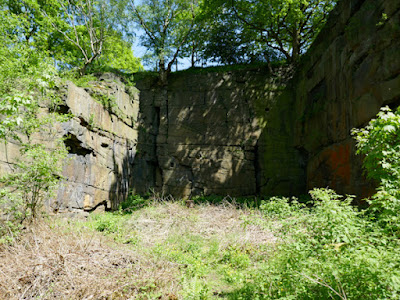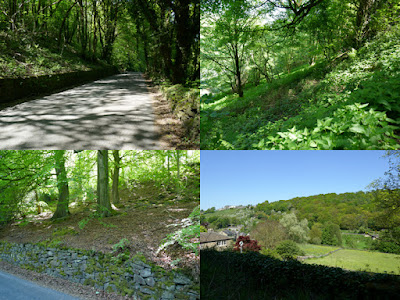 |
| The topography around Honley |
Arriving at the path leading up to Honley Quarry, I had by now photographed only 11 of the 29 listed buildings that I selected from the results of my British Listed Buildings Photo Challenge for Honley; however, I had walked for more than 3 km since leaving Honley railway station, with the lowest point being 105 m at Honley Bridge and rising to a maximum of 163 m at the corner of Scotgate Road and Hassocks Lane.
The Rough Rock forms a plateau that dips in a north-easterly direction and underlies Honley, with the escarpment above the Mag Brook valley being once extensively quarried at the Scot Gate Head Quarry. I had so far seen many examples of sandstone in the listed buildings and various other cottages, terraced houses and the boundary walls, but I didn't stop to examine it closely.
The entry for Honley Quarry on the Kirklees Climbing website provides a good introduction to this quarry, with photographs of the various rock faces and routes faced by the climbers who seem to regularly practice their skills here. As a geologist, I just had a short time to look at the principal physical characteristics of the Rough Rock here and take a few record photographs, for examination at a later date.
Entering the quarry, I firstly noticed that it comprises two rectangular pits more than 15 metres deep, which are set at right angles to each other to form an L-shaped layout. Turning into the first smaller north-eastern pit, I could immediately see that the Rough Rock is massively bedded with large scale cross-bedding.
The geological memoir (1933) makes several references to the Rough Rock around Honley, describing the Scot Gate Head Quarry as still being operative and producing a very even grained. It goes on to say that it was used widely for public works and buildings in several towns in Yorkshire and Lancashire and, reputedly, it was also used at York Castle.
I have seen the Rough Rock at a few places in Sheffield, where the formation is flaggy and has been exploited for stone slate roofing and flagstones, but further north in West Yorkshire it can be very coarse grained with fingernail sized pebbles of vein quartz – as I have seen in an old quarry in Roundhay Park and where used as a building stone at Kirkstall Abbey and Leeds Minster.
The specimen that I collected using my Estwing hammer is a fine grained, well bedded sandstone where individual bedding planes can be seen with the naked eye. Iron staining, with the development of Liesegang rings, gives the stone its general colour, but part of the fresh face of the specimen has a distinct blue/grey colour variation – indicating a change in the oxidation state of its iron bearing minerals.
Taking a quick look at the jointing pattern in the quarry faces, I noted a few very wide joints that have been partially filled in with squared and coursed stonework, which seemed very strange to me as I can’t think of a reason why this would be done – unless by the climbers themselves, to stabilise sections of the quarry face.
The geological memoir also describes the strata below the Rough Rock as containing a lot of black and blue shale with ironstone nodules and the high iron content of the sandstone is reflected in its often orange colour – particularly on the joint planes and weathered surfaces.
It further mentions that, in some of the quarries, there are numerous large ferruginous spherical concretions that are known locally as ‘mare-balls’. Although I didn’t notice any of these, I did see a couple of places where incoherent sandy masses have been differentially weathered.
I spent less than 15 minutes looking around the quarry, which is dominated by exposures of massive cross-bedded sandstone, with the cross-bedding being flaggy in places, but I did not see any of the lower beds that are sufficiently distinctive from the upper massive beds to be mapped separately as the Rough Rock Flags.



















































